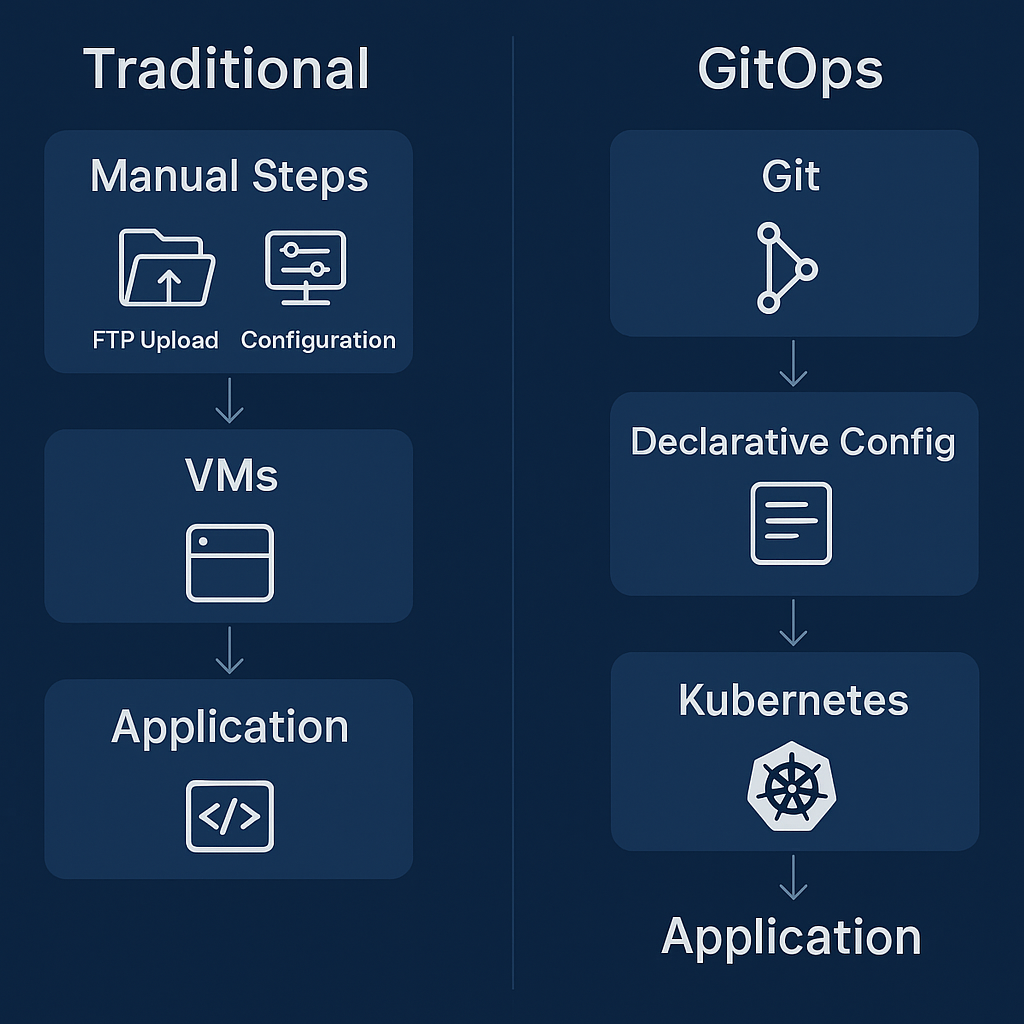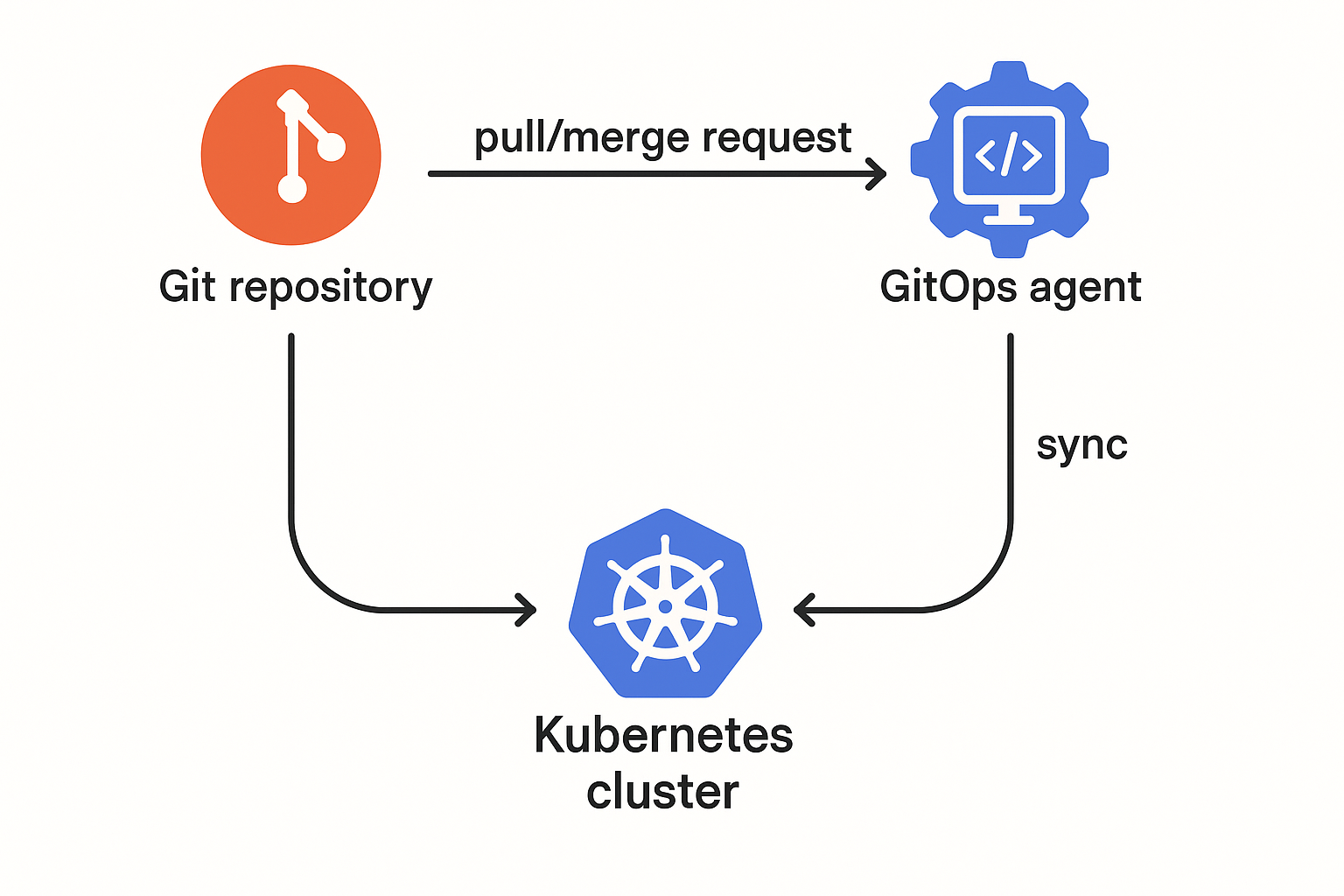1. Introduction: Why Everyone’s Talking About GitOps in 2025
It’s 2025, and building software is more cloud-driven than ever. Cloud computing offers incredible speed and flexibility, but it also brings complexity. Companies are expected to ship new features rapidly, maintain high uptime, ensure security, and adapt to constant changes. Traditional methods of updating software, often manual or relying on basic scripts, can’t keep pace anymore. They lead to delays, errors, and operational chaos.
This is where GitOps comes in. Once a new concept, GitOps is now a foundational standard for managing modern applications, especially in Kubernetes environments. By the end of 2023, GitOps adoption surged, highlighting its role as a crucial pillar of software operations. It brings automation, consistency, and traceability to the otherwise chaotic world of cloud-native software.
2. How We Used to Do It: The Days Before Kubernetes
Let’s rewind to the early days of application deployment.

- 1990s–Early 2000s: Websites were manually uploaded via FTP. A developer built a site on their machine and uploaded it to a live server.
- Source Control Evolution: Tools like CVS and Subversion (SVN) improved code versioning. However, pulling updates manually—risky and error-prone.
- Shared Hosting: Platforms like cPanel simplified hosting but didn’t address complex deployments.
- Virtual Machines (VMs): Technologies like VMware allowed teams to package full environments. However, VMs were heavyweight – each requiring a full OS, consuming lots of resources.
- Automation Tools: Jenkins automated code building, and configuration tools like Puppet, Chef, and Ansible automated server setups. Still, the process remained imperative-scripts dictated step-by-step actions.
Common Problems with Old Methods:
- Manual deployments caused human errors.
- Development and production environments often drifted apart.
- Scaling required tedious, manual intervention.
- Rollbacks were often manual and unreliable.
- Resource wastage due to VM overhead.
All of these paved the way for a new model: containers and eventually, Kubernetes.
3. Kubernetes Arrives: The Engine of Modern Software (by 2025)

Containers (popularized by Docker) solved the “dependency hell” by bundling apps and their dependencies together.
Kubernetes took this a step further by orchestrating containers at scale.
Why Kubernetes Dominates in 2025:
- Automation: Handles scaling, failover, and deployments automatically.
- Resilience: Automatically restarts failed apps and self-heals.
- Portability: Runs across clouds and on-premise consistently.
- Efficiency: Smartly schedules containers to maximize resource usage.
- Declarative Management: Users define the desired end state, and Kubernetes ensures reality matches it.
However, Kubernetes alone doesn’t enforce how you manage your configurations securely or consistently.
That’s where GitOps shines – layering an operational discipline on top of Kubernetes’ power.
4. What Exactly is GitOps? Why It Works in 2025
GitOps = Git + Operations.
It treats Git as the single source of truth for system configurations and uses automated agents to continuously apply these configurations to live systems.

The Four Principles of GitOps:
- Declarative Everything: Define desired state (in YAML, HCL, etc.), not step-by-step actions.
- Git as Source of Truth: Only Git holds the official configuration. No ad-hoc manual changes.
- Pull/Merge Requests for Changes: All changes go through versioned Pull Requests (PRs) for approval and auditability.
- Continuous Reconciliation by Agents: GitOps tools (like Argo CD or Flux) continuously watch Git and reconcile live environments.
Benefits of GitOps:
- Faster releases through automation.
- Safer operations thanks to versioned audits.
- Easy rollbacks by reverting Git commits.
- Consistent environments across dev, test, and production.
- Improved security by minimizing direct access to live systems.
GitOps moves from push-based CI/CD to pull-based operations, enhancing security and reliability.
5. A Moment in History: How GitOps Began
Alexis Richardson, CEO of Weaveworks, introduced GitOps in 2017.
The early vision:
“Manage your entire system declaratively with Git and apply changes through Pull Requests.”
Though the core concepts like automation and Infrastructure as Code existed earlier, GitOps introduced a clear, Kubernetes-native approach that resonated with the community.
The name cleverly aligned with “DevOps,” highlighting its focus on developer empowerment in operations.
6. The GitOps Toolkit in 2025: Argo CD vs Flux CD
Two CNCF-graduated projects dominate GitOps today:
| Feature | Argo CD | Flux CD |
| CNCF Status | Graduated (Dec 2022) | Graduated (Nov 2022) |
| Design | All-in-one GitOps application manager | Modular GitOps toolkit |
| User Interface | Strong built-in web UI | CLI-first, external UI optional |
| Flexibility | Medium | Very high |
| Config Sources Supported | Git, Helm (improving OCI support) | Git, Helm, OCI, S3 Buckets |
| Rollouts and Progressive Delivery | Argo Rollouts integrated | Flagger integrated |
| Adoption | Large enterprises | Embedded in many cloud platforms |
👉 Choose Argo CD if you want a powerful UI and straightforward app management.
👉 Choose Flux if you need modular, flexible workflows or advanced multi-source syncs.
Other important tools in the GitOps ecosystem include:
- Infrastructure as Code: Terraform, OpenTofu
- Policy as Code: OPA, Kyverno
- Developer Platforms: GitLab, Devtron, Harness, Spacelift
7. Old Deployment vs GitOps Workflow (2025)
| Aspect | Old Way | GitOps Way |
| Setup | Manual server/VM config | Declarative IaC (Terraform, YAML) |
| Code Build | CI builds and deploys | CI builds; GitOps triggers deployment |
| Deployment Trigger | Push-based (direct action) | Pull-based (agents pull from Git) |
| Source of Truth | Scattered (scripts, manual changes) | Centralized in Git |
| Rollback | Manual and risky | Git revert and auto-sync |
| Security | CI needs production access | Only GitOps agent needs minimal access |
| Operational Model | Imperative (step-by-step) | Declarative (define desired state) |
GitOps significantly reduces risk, increases transparency, and automates recovery compared to old methods.
8. 🚀 GitOps: Push vs Pull – Where we are and where we’re headed
If you’ve worked with Kubernetes or cloud-native systems lately, chances are you’ve heard about GitOps—the practice of using Git as the source of truth to manage your infrastructure and applications.
But one key question often pops up: Should you go with a push-based or pull-based GitOps model?
Let’s break it down.
🔁 Pull vs 🚀 Push – The Big Picture
- Pull-based GitOps is what most people associate with tools like Argo CD and Flux. Here, a GitOps agent runs inside your cluster and continuously watches your Git repo for changes. If something changes, it pulls that update into the cluster.
- Push-based GitOps is more like a traditional CI/CD flow. Your pipeline (Jenkins, GitHub Actions, GitLab CI, etc.) pushes changes to your cluster as part of the pipeline run.
So what’s the difference in spirit?
Pull = declarative, autonomous clusters.
Push = controlled, event-driven pipelines.
9. GitOps adoption: Where we stand
GitOps is no longer bleeding edge—it’s going mainstream.
We’re seeing platform engineering teams standardize on GitOps workflows to enforce consistency, traceability, and safer deployments.
Modern platform stacks often include Argo CD or Flux as day-one tools.
Also, with CI/CD pipelines shifting left and Kubernetes becoming the default runtime, GitOps fits naturally into that workflow. It’s infrastructure as code, now with operational maturity.
📈 Why GitOps Adoption Is Growing
- Auditability: Everything lives in Git. You get history, diff, rollbacks, PR reviews.
- Standardization: It unifies workflows across dev and ops.
- Self-healing (especially in pull): Drift? The agent will fix it.
- Security: In pull-based models, you don’t expose the cluster to external push traffic.
Add to that the growing complexity of cloud systems, and GitOps becomes a much-needed compass in a multi-cloud storm.
10. Adoption Barriers: Why Some Teams Struggle
Let’s be real—GitOps isn’t plug-and-play for everyone.
- Steep learning curve for teams new to declarative infrastructure
- Tooling fragmentation (Flux, Argo, Jenkins X, custom scripts)
- Security concerns over Git access and secret management
- Cultural shift: GitOps requires treating infrastructure like application code, which is still new for many ops teams
For push-based GitOps, misconfigured pipelines can become a single point of failure.
For pull-based, debugging reconciliation logic can be mystifying for newcomers.
✅ Best Practices: Push & Pull GitOps
- Keep Git the single source of truth, no matter the model
- Use signed commits or tags to ensure trusted changes
- Secure your pipelines and agents (limit permissions!)
- In pull-based models: use health checks and progressive delivery
- In push-based: make sure pipelines fail fast and provide observability
And remember: this isn’t a binary choice. Hybrid models are emerging, especially in large orgs—push for speed, pull for stability.
11. Conclusion
The truth is—there’s no one-size-fits-all GitOps model.
- If your priority is security, autonomy, and resilience, especially across multiple clusters, a pull-based model like Argo CD or Flux is likely the best fit.
- If you’re coming from a strong CI/CD background and need tight control and sequencing, push-based GitOps might align better with your existing pipelines.
In many cases, the answer isn’t either/or—it’s both.
Hybrid approaches are becoming more common, blending the best of both worlds: push for velocity, pull for safety and drift correction.
Start with your team’s operational maturity, compliance needs, and deployment frequency—then choose the model that supports your culture and scale.
In the end, GitOps isn’t just about tooling—it’s about trust, visibility, and automation at the speed of cloud-native.
We’re heading into a future where GitOps is not just a tool—it’s a platform capability. Expect tighter integrations with policy engines (like OPA/Gatekeeper), better UX, and GitOps-native security features.
Also? The rise of event-driven and AI-assisted GitOps will change how we reason about change. We’re just getting started.